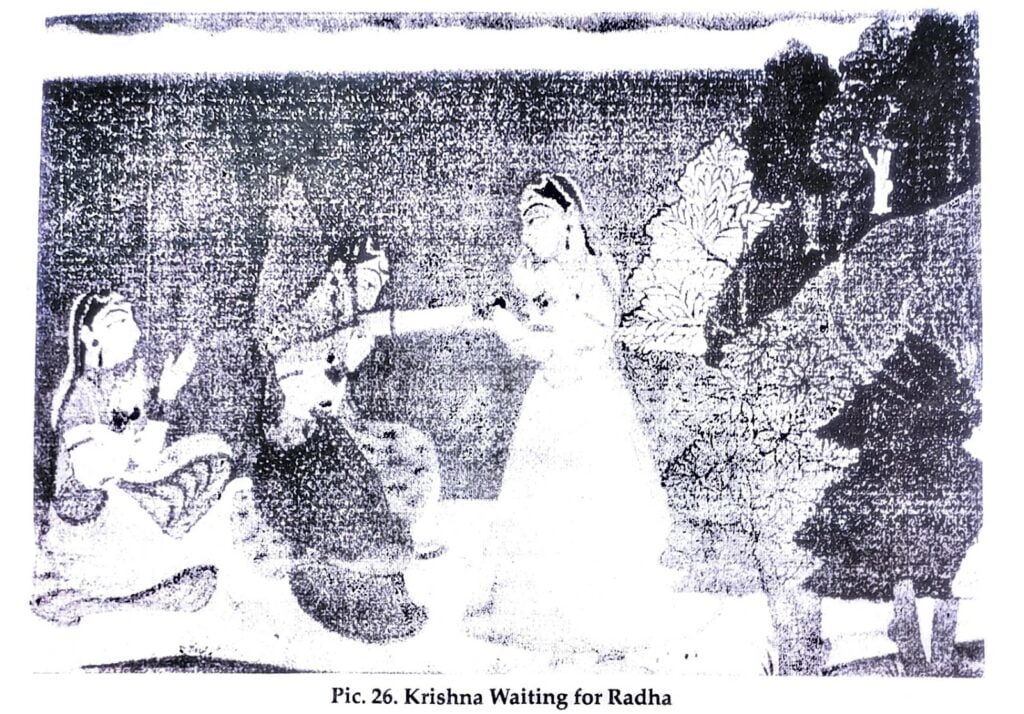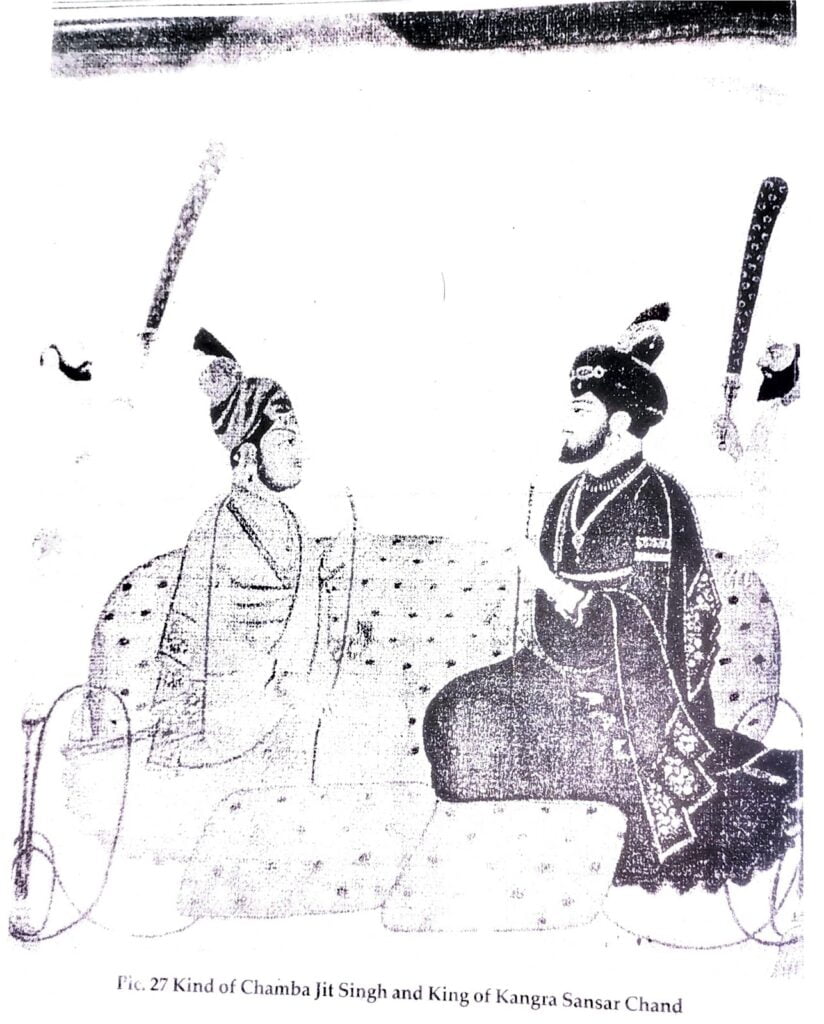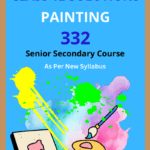NIOS Class 12 Painting Chapter 9 Pahari School of Miniature Painting Solutions to each chapter is provided in the list so that you can easily browse throughout different chapters NIOS Class 12 Painting Chapter 9 Pahari School of Miniature Painting and select need one. NIOS Class 12 Painting Chapter 9 Pahari School of Miniature Painting Question Answers Download PDF. NIOS Study Material of Class 12 Painting Notes Paper 332.
NIOS Class 12 Painting Chapter 9 Pahari School of Miniature Painting
Also, you can read the NIOS book online in these sections Solutions by Expert Teachers as per National Institute of Open Schooling (NIOS) Book guidelines. These solutions are part of NIOS All Subject Solutions. Here we have given NIOS Class 12 Painting Chapter 9 Pahari School of Miniature Painting, NIOS Senior Secondary Course Painting Solutions for All Chapter, You can practice these here.
Pahari School of Miniature Painting
Chapter: 9
PAINTING
Krishna Waiting For Radha (Pic. 26)
| Title | Krishna waiting for Radha |
| Medium | Tempera on Sialkoti paper |
| Period | 1730 A.D |
| Size | 12.2″×8.1 |
| Theme | A very popular theme of Krishna Leela |
| Style | Basholi |
| Artist | Manku |
| Technique | Tempera |
| Collection | National Museum New Delhi |

“Geet Govinda” was written by Bengali poet Jaidev on ‘Krishna-Leela’ during 11th CA.D. and became famous all over India. The painters of Basohli were influenced by poetic descriptions of “Krishna-Leela” and used these most beautifically in their paintings. This painting is one of those, in which Krishna, Radha and her friends are shown. The allegorical presentation of Krishna and Radha as Parmatama (Supreme being) and Atma (human being) respectively and the Gopinis (friends) as ‘Guru’ (Preceptor), elevate the theme to a spiritual level. The Guru persuades a person to meet “Paramatma”, as Gopinis are trying to persuade Radha to meet waiting Krishna.
Basohli paintings are characteristic by flat backgrounds with simplified forms of trees. Faces are in profile and color are warm and bright.
King of Chamba jit Singh and King Kangra Sansar Chand (Pic. 27)
| Title | Kings of Chamba and king of Kangra |
| Medium | Water colors |
| Period | Circa 1800 A.D |
| Size | 28.5×22cm. |
| Theme | Chamba king Jeet Singh and Kangra king Sansar Chand in a courtesy meeting |
| Technique | Tempera |
| Material | Paper (hand made) |
| Artist | Nain Sukh |
| Collection | National Museum, New Delhi |
Raja Sansar Chand was a great patron of art. His age was a golden age of Indian painting of the pahari school. The painting portrays the friendship of two rulers of Pahari States and art-lovers. Raja Jeet Singh of Chamba and Raja Sansar Chand are relaxing and smoking from Hukka. In a background of yellow space and blue sky, the Royal costumes look very colorful. The kings are surrounded by attendants. This is a very fine example of portraiture of Pahari school of Kangra.
Intext Questions 9.1
Choose the right answer:
1. This painting belong to the style of
(a) Kishangarh.
(b) Basholi.
(c) Chamba.
Ans: (b) Basholi.
2. The painter was inspired by the following book
(a) Shrimad Bhagwat.
(b) Mahabharata.
(c) Geeta-Govinda.
Ans: (c) Geeta-Govinda.
3. Match the following.
| (a) Radha | (a) Atma |
| (b) Krishna | (b) Guru |
| (c) Gopini | (c) Parmatma |
Ans:
| (a) Radha | (a) Atma |
| (b) Krishna | (b) Parmatma |
| (c) Gopini | (c) Guru |

Intext Questions 9.2
Fill up the blanks:
1. This painting is painted by __________.
Ans: Nain Sukh.
2. This painting belongs to __________ school.
Ans: Pahari School.
3. The enlisted painting is a good example of __________ Pahari School.
Ans: Portraiture.
Model Questions
1. Describe the main theme of Pahari painting.
Ans: Themes of Pahari miniature paintings are influenced by classical literature, music and local cultures. The painters are masters in expressing the beauty of nature and women.
These paintings are done on handmade paper, which is made of bamboo, cotton and other materials. These are popularly known as “Sialkoti paper”. After the lines are drawn on the paper it is given a coat of white colour. The surface of the paper is published by rubbing a smooth stone on it and colours are applied on this surface. The painters also used stencils to reproduce more copies of the painting.
2. What do you know about the characteristic features or Pahari painting.
Ans: The school is characterized by its tender coloring, sensitive and emotional style and more convincing use of perspective and foreshortening.
3. Describe the painting “Krishna is waiting for Radha”.
Ans: “Geet Govinda” was written by Bengali poet Jaidev on ‘Krishna-Leela’ during 11th C.A.D. and became very popular all over India. The painters of Basholi were influenced by poetic descriptions of “Krishna-Leela” and used these most romantically in their paintings. This painting is one of those, in which Krishna Radha and her friends are shown. The allegorical presentation of Krishna and Radha as Parmatma (Supreme being) and Atma (human being) respectively and the Gopinis (friends) as ‘Guru’ (Preceptor), elevate the theme to a spiritual level. The Guru persuades a person to meet “Paramatma”, as Gopinis are trying to convince Radha to meet waiting Krishna.
4. Throw some light on the technique of Pahari miniature painting.
Ans: These paintings are done on handmade paper, which is made of bamboo, cotton and other materials. These are popularly known as “Sialkoti paper”. After the lines are drawn on the paper it is given a coat of white color. The surface of the paper is published by rubbing a smooth stone on it and colors are applied on this surface. The painters also used stencils to reproduce more copies of the painting.
Very Short Type Questions Answer
1. Name the main centers of Pahari painting.
Ans: Basholi, Gular, Kangra, Chamba, Mandi, Kullu, Bilaspur, Jammu, Nalagarh, Garhwal, Kashmir, Dharamshala etc.
2. What is other name of Pahari school of painting?
Ans: Pahari Qualam.
3. What do you understand by “Sialkoti paper”?
Ans: Pahari painting are done on handmade paper, which is made of bamboo, cotton and other materials. These are popularly known as “Sialkoti paper”.
4. When did Pahari school begin to decline?
Ans: 19 C.A.D.
5. Who painted the painting “Krishna waiting for Radha”?
Ans: Jaidev.
6. What inspired the painting “Krishna waiting for Radha”?
Ans: A poem called “Geet Govind” composed by Jaidev.
7. Who painted “Krishna waiting for Radha”?
Ans: Manku.
8. What are characteristics of Basohli paintings?
Ans: Basohli painting are characterized by flat background, with simplified forms of trees. Faces are in profile and color are warm and bright.
9. Give an example of a painting from pahari school of Kangra.
Ans: King of Chamba and king of Kangra.
10. What is the theme of the painting “King of Chamba Jeet Singh and King of Kangra?
Ans: Chamba king Jeet Singh and Kangra king Sansar Chand in a courtesy meeting.
Short Type Questions Answer
1. How did Pahari school of painting develop?
Ans: A new style of painting that developed in the Himalaya foot-hills of Punjab, Garhwal and Jammu is known as “Pahari Qualam” or Pahari school of painting. The local folk art form of this area was influenced by painters of Mughal court, when they took shelter in the Hindu states of this area due to the invasion of Nadir Shah. Pahari Qualam is a beautiful combination of natural beauty of this region and the glamour of Mughal court of Delhi. Under the patronage of the small kings of the hill-states, it spread through Jammu to Tehri and Pathankot to Kullu.
2. Describe the Pahari school of miniature painting.
Ans: A new style that was developed in the Himalaya foot-hills of Punjab, Garhwal and Jammu is known as “Pahari Qualam” or Pahari school of painting. The local folk art form of this area was influenced by painters of Mughal court, when they took shelter in the Hindu states of this area due to the invastion of Nadir Shah. Pahari Qualam is a beautiful combination of natural beauty of this region and the glamour of Mughal court of Delhi. Under the patronage of the small kings of the hill-states, it spread through Jammu to Tehri and Pathankot to Kullu. The painters maintained the indigenous style in spite of the Mughal influence. The Pahari school narrates Indian Mythological and religious stories. Portrait paintings were also very popular among the patrons of this school. Though the characters are from Hindu religious stories, they are sometimes shown in Mughal costumes. The artists of Jammu, Kangra and Guler combined the best aspects of Mughal and Rajasthan styles. The main centers of Pahari school were Basohli, Guler, Kangra, Chamba, Mandi, Kullu, Bilaspur, Jammu, Nalagarh, Garhwal, Kashmir, Dharmshala etc.
3. Describe the painting “Krishna waiting for Radha”?
Ans: “Geet Govinda” was written by Bengali poet Jaidev on ‘Krishna-Leela’ during 11th C.A.D. and became very popular all over India. The painters of Basohli were influenced by poetic descriptions of “Krishna-Leela” and used these most romantically in their paintings. This painting is one of those, in which Krishna, Radha and her friends are shown. The allegorical presentation of Krishna and Radha as Parmatma (Supreme being) and Atma (human being) respectively and the Gopinis (friends) as ‘Guru’ (Preceptor), elevate the theme to a spiritual level. The Guru persuades a person to meet “Paramatma”, as Gopinis are trying to convince Radha to meet waiting Krishna.
4. Describe the painting “king of Chamba Jeet Singh and king of Kangra Sansar Chand”?
Ans: Raja Sansar Chand was a great admirer and patron of art. His time was a golden age of Indian painting of the pahari school. The painting documents the friend ship of two rulers of Pahari States and art-lovers. Raja Jeet Singh of Chamba and Raja Sansar Chand are relaxing and smoking from Hookah. In a background of yellow space and blue sky, the Royal costumes appear very colorful. The kings are flanked by attendants. This is a very good example of portraiture of Pahari school of Kangra.
5. Which types of paintings were popular in Pahari school?
Ans: Pahari School of painting is quite distinct from Rajasthani school. This region was more exposed to different religious beliefs and Mughal influence. The school is famous for beautiful flowing lines and brilliant colors. The court painting of portraits become popular along with literary, mythical and secular themes. The painters of Pahari School were great lovers of nature and depicted nature with care and love in their paintings.

Hi! my Name is Parimal Roy. I have completed my Bachelor’s degree in Philosophy (B.A.) from Silapathar General College. Currently, I am working as an HR Manager at Dev Library. It is a website that provides study materials for students from Class 3 to 12, including SCERT and NCERT notes. It also offers resources for BA, B.Com, B.Sc, and Computer Science, along with postgraduate notes. Besides study materials, the website has novels, eBooks, health and finance articles, biographies, quotes, and more.



